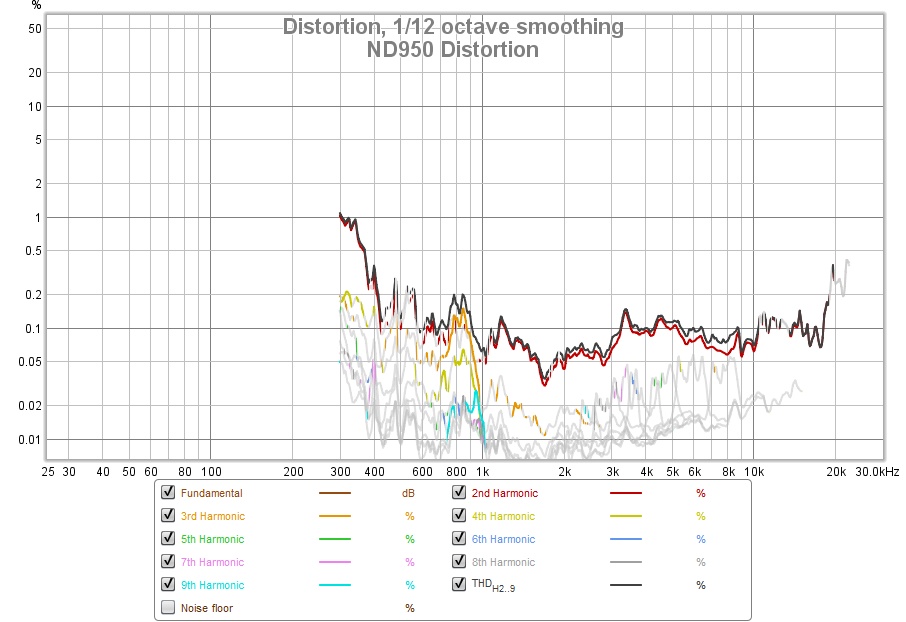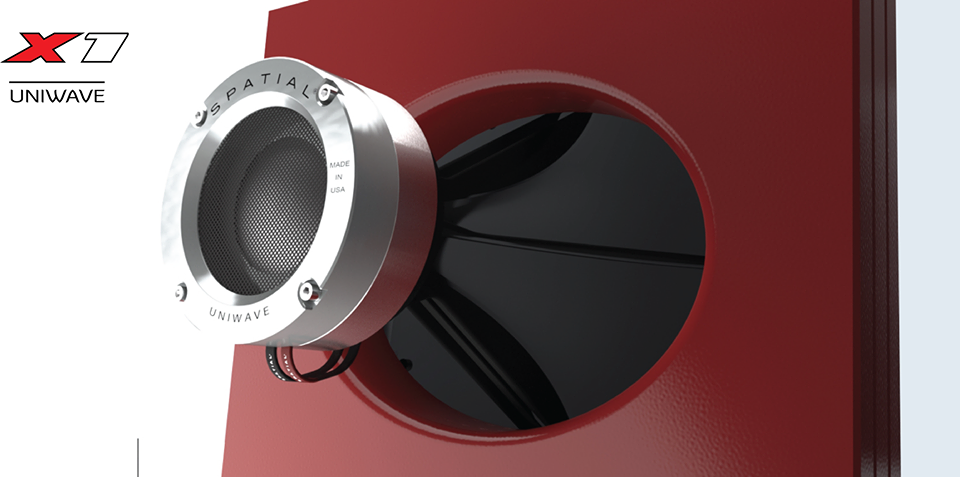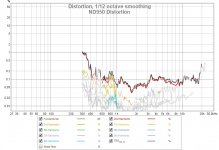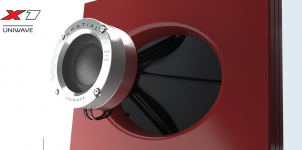Not overkill, in my opinion.
We use compression drivers rated for 120watts at 1watt....
So a large woofer system or a system with high accumulated cone surface area... Its the same philosophy isn't it? A super dynamic capable system (among other things of course!) use at lowest input levels (home levels), results in desirable SQ....I'm sure there's a point of diminishing returns that is based off listening levels and other thins.
Dynamic and clean, that is the key. For example, In the Hall of the Mountain King or Ride of the Valkyries (or the Ring as whole) do not sound right without the dynamic reserve of large speakers (or better horns🙂 ). For me, there is no such thing as a too big speaker, if it can fit the room.
...
Below are a set of measurements made from one, recently put up on the Square Wave thread.... good square waves are even harder to get than flat mag and phase traces...
I've also made modular MTM's, MMT transmission's, and simple MT's, all with the same drivers.
All measured nearly identical in the far field where imaging becomes optimal (>3x longest speaker dimension ),
but the MTM's "virtual vertical center" gave it a bit of an imaging edge.
Out of the various builds I've tried, I think a synergy may be the only one that has better potential imaging.
Anyway, my 2 cent recommendation
Good stuff Mark....I;m not the expert but I know of believe in the square wave theory, and I'll tell ya, I don't know if I've ever seen such a nice reproduced square wave....actually wtf? lol
I wanted to use the biggest drivers possible. We always say that everything is a trade and I've made it the main theme of this build to create a system that had great dynamic accuracy (possible the same thing as dynamic contrast), in order to grab every little bit of it, I decided that the largest driver possible for each band lends towards that goal. I took to a comment, made about not wanting to use a woofer with a mms higher than a certain mass, if said woofer were to be a mid, regardless of diameter...the 15m was either at the number or very close. This is a subjective stance that I think has been proven to be true. Musical instruments are said to sound more realistic with lighter cones.
Light cones - does this mean ribbons? There's a number of projects on klipsch forum Double Stack ESS AMT-1 with Wings--Possible Kit for Heritage - Technical/Modifications - The Klipsch Audio Community
I don’t think ribbons have cones but they sure do fall in category of light diaphragm. I have thing for AMT’s...maybe one day we can put together a large horn for one.
True, if you want me to stop just let me know 🙂
Fair enough, ask yourself why though.
If the physical height of the speaker is an issue then polar position makes more sense, if you can move it up and down then I don't think that represents a real problem, more of a choice, make sure to look at some sims of the lobes you will generate to make sure that is trade a off you are happy with.
I have attached two screenshots from rephase showing an LR96 linear phase crossover. With no optimization 16384 taps is needed to get an exact match to the textbook slope. You can see that the red and blue lines are virtually on top of each other. Blue is ideal red is actual. That gives 185ms latency, so less than 2/10 ths of a second after pressing play before sound starts.
If that is too much with a little optimization, you can get the same exact match with a 4096 tap filter and 46ms delay. You could take it further if 46ms of your time is too precious to waste after pressing play to hear sound 🙂
The flat line through the middle of the graphs is the phase response.
That being said minimum phase LR4 acoustic is still a good target.
If you want to go MTM then I think you should seriously consider putting the waveguide in the box with the woofers for the reduction in diffraction or if nothing else just to make it easier to build. Diyuser's speaker above is a very good model to start from.
You would say that 😉 No offence was meant by it, your's is the build I was referencing and I think it is very well thought out. I came very close to buying 4 15PR400's after seeing it as I have the same horns sitting around, who knows maybe I still will 🙂
I just meant you covered many areas. Don't stop lol, its very thought provoking.
Stereo bass just makes sense to me, it also compliments the experience when I play video games. Same thing goes for latency. As a competitive gamer I am familiar with ms as a unit of time. We are constantly improving latency from input and visual devices. Also, input latency and keyboard drumming has exposed me to latency and its limitations. So I just opened my DAW to test out some latencies . I think I have been over critical in the past....but at the same time maybe not...I stated that 10ms was my tolerance but I skewed my perception by not taking overall latency into context which is a combination of input and output latency. Whoops. So lets see...... 48ms....unacceptable.... 24ms just tolerable,barely detectable. Hmm interesting. I have no idea what type of latency I'm getting from my computer keyboard...I know my mouse is 2ms...Ill hook my musical keyboard later and try again. With Asio the latency should match what the daw says. I might be getting a latency of about 7ms from my computer keyboard. Maybe linear will work after all.
The height issue is the idea that the top of the enclosure would be several inches way from the ceiling. Now I'm just a renter, once I buy a house or maybe get a house built, that fill change for the better. As for the the issue of diffraction, what if I put the horn in its own, separate box? When stacked they will act as one plane. That was idea anyway.
Last edited:
Thx Camplo,Good stuff Mark....I;m not the expert but I know of believe in the square wave theory, and I'll tell ya, I don't know if I've ever seen such a nice reproduced square wave....actually wtf? lol
You know, in the pure analog days, before digital and FFT measuring, square waves were the way to measure frequency response's magnitude and phase. No theory to it at all...pure simple science.
But with FFT so easily implementable, square wave speaker measuring is clearly an anachronism.
The few times I've tried square wave testing were out of curiosity, and it has been clear it is even a more precise measuring technique than FFT.
FFT seems forced to mathematically stitch together a curve across the spectrum, to present something intelligible.
Square waves just measure/picture the relationship of each frequency and its fundamentals without any need to consider other parts of the frequency range.
Anyway, just a little measurement sidetrack info, as measurement tuning is a big part of the audio hobby for me..
If folks were to measure with square waves today, after having tuned mag and phase precisely flat with dsp processing driven by FFT measurements, you would see more sets looking like i posted.
Such sets were really next to impossible before dsp and linear phase i think....
But why bother with square waves today?
....hence no really good looking sets, yesterday or today........
Anyway again, what i posted is both totally real, and totally too good to be true 😉
Too good to be true because it was perfect tuning to just one mic location.
That's easy to do...too easy really...but it does show the tools we have available today to make precise tuning.
The real trick to tuning ime/imho, is to back away from one spot tuning, and find broader brush strokes that benefit wide coverage areas.
Related aside.... whatever you end up building, i would strongly encourage you to envision a prototyping, measuring and altering kinda process.
I've found once sawdust is made, things often turn into 'plans of mice and men'.
This is huge part of speaker tuning / building ime/imo. 🙂
The "broader brush" is for some, I think application comes to mind. I'd think that one spot tuning, within that one spot, is going to have better results than if you average several listening spots. Could be wrong.
Regarding AMTs - have you seen this before? Double Stack ESS AMT-1 with Wings--Possible Kit for Heritage - Technical/Modifications - The Klipsch Audio Community
Looks like a great option for a two way system.
Looks like a great option for a two way system.
Regarding AMTs - have you seen this before? Double Stack ESS AMT-1 with Wings--Possible Kit for Heritage - Technical/Modifications - The Klipsch Audio Community
Looks like a great option for a two way system.
I want to cross lower than that. AMT's capable.
The "broader brush" is for some, I think application comes to mind. I'd think that one spot tuning, within that one spot, is going to have better results than if you average several listening spots. Could be wrong.
yeppa, i thought that too for a while...and totally agree re application..
i guess the real trick is making that 'one spot' sufficiently big enough to cover audience goals, even if it's for an audience of only one peep
don't mean to digress, but i often think stereo, chasing the stereo illusion, has done more to harm audio science than any single item.....makes the "spot" have to fall on a bisecting line...
Some RCF ND950 distortion measurements
I made a measurement of distortion for ND 950 in HF 950 horn at 1m distance. I used Neumann KM 183 omni mic. Not a measurement microphone, but it is of better sound quality than UMIK-1. Distortion figures are better with Neumann than when measured with UMIK-1.
Neumann mic is plugged into Focusrite Clarett 2Pre USB. Its line output is connected to an Arcam amplifier. There was an autoformer from Bob Criter + 8,2Ohm resistor between amp and compression driver.
Measurement from 300 up to 45000 Hz. 96000 sample rate.
Distortion figures (normalized) are as follows:

I made a measurement of distortion for ND 950 in HF 950 horn at 1m distance. I used Neumann KM 183 omni mic. Not a measurement microphone, but it is of better sound quality than UMIK-1. Distortion figures are better with Neumann than when measured with UMIK-1.
Neumann mic is plugged into Focusrite Clarett 2Pre USB. Its line output is connected to an Arcam amplifier. There was an autoformer from Bob Criter + 8,2Ohm resistor between amp and compression driver.
Measurement from 300 up to 45000 Hz. 96000 sample rate.
Distortion figures (normalized) are as follows:
Attachments
Not a measurement microphone, but it is of better sound quality than UMIK-1
How so? I'm not saying you are wrong, just want to know. You have to have calibration file for this mic? Probably cant trust it past ~3khz, starts to change in sensitivity on up....priuce sure is different lol!
Its really frustrating that they don't give the xmax-thiele specs for compression drivers and their diaphragms.

This is the Radian that they used to cross at 300hz.... on a 800hz horn....I read that the company worked with Radian to produce this compression driver but thats all I know.
This is the Radian that they used to cross at 300hz.... on a 800hz horn....I read that the company worked with Radian to produce this compression driver but thats all I know.
Attachments
Last edited:
How so? I'm not saying you are wrong, just want to know. You have to have calibration file for this mic?!
I made recordings with both. It's clear which one catches more details.
I made a calibration for Neumann based on calibrated Umik-1. Neumann is linear until about 2Khz and then become hotter until 10Khz. Made measurements using both placed side-by-side, then divided in REW and got a calibration curve for Neumann.
Chebum, what SPL ? Needs that reference, along with noise floor when levels so low...
As far as I remember around 90-100 in 1 meter. Louder than i'd listen to. Will check tomorrow.
Last edited:
Has anyone ever actually read the page on transmission lines on wiki? I don't know if to trust it or disregard. Theres some different philosophy on there that I've never read anywhere else. Thank God for GM because there are so many people with opinions on what a Transmission Line is or could be or should be, and non of these people have ever built a damn TL, or if they did, they've built or heard 1 or 2 out a very large amount of possible and claimed successful configurations, and then even the people with a wealth of experience disagree, so I think it turns into a personal, or personality type type choice and I I like GM's style so...boom. My 3d iteration of GM's design turned out pretty good I'd say, its a little beyond some's perception but given my design goals and the anticipated performance of anything that resembles what GM's original design intends, I'll be a happy camper. My design ended up being ~16" over but I also modified the design by exiting the taper all the way to terminus and only a few inches before terminus does the line reach the lowest CSA that originally occupied the last 10" of the design. Still chippin at it, but I think its turning out well.
Wiki TL?
3d iteration? If you mean this and drawn to scale it likely won't perform like you think: https://www.diyaudio.com/forums/att...pl-low-distortion-2-a-reiterationgm-mlttl-jpg
Better to just make mine larger, longer.
GM
3d iteration? If you mean this and drawn to scale it likely won't perform like you think: https://www.diyaudio.com/forums/att...pl-low-distortion-2-a-reiterationgm-mlttl-jpg
Better to just make mine larger, longer.
GM
Wikipedia = wiki
Actually the re-iteration is bigger than the original. But more importantly it’s square and has a front facing port. What issue do you have with the folded version I wonder.
Actually the re-iteration is bigger than the original. But more importantly it’s square and has a front facing port. What issue do you have with the folded version I wonder.
I got that far, but searching only got me the math: Engineering Acoustics/Print version - Wikibooks, open books for an open world
If you read the Ariel thread, you'll find the staggered 'steps' must be well defined to act as a significant acoustic impedance.
GM
If you read the Ariel thread, you'll find the staggered 'steps' must be well defined to act as a significant acoustic impedance.
GM
- Home
- Loudspeakers
- Multi-Way
- Is it possible to cover the whole spectrum, high SPL, low distortion with a 2-way?


